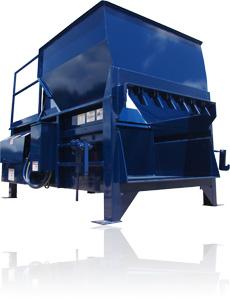Baler Rental Solutions for Your Hazardous Waste Requirements
Baler Rental Solutions for Your Hazardous Waste Requirements
Blog Article
Exploring the Vital Function of Waste Equipment in Modern Recycling Processes and Sustainable Garbage Disposal Practices
The critical duty of waste tools in contemporary recycling processes emphasizes its importance in attaining sustainable waste disposal techniques. Advanced systems, such as automated arranging modern technologies and compactors, not just improve efficiency but additionally play a pivotal role in reducing contamination rates and improving product recovery. As the need for even more lasting options grows, it is vital to take a look at just how these modern technologies adapt to advancing obstacles within waste monitoring. What cutting-edge improvements are on the perspective that could even more change these processes?
Relevance of Waste Tools
Why is waste devices critical in the recycling process? The performance of recycling procedures pivots considerably on the schedule and capability of waste equipment. This group of machinery and devices is important for the effective collection, handling, and sorting of recyclable materials. By promoting the separation of products, waste devices reduces contamination, which is vital in ensuring high-grade recyclables that can be reestablished into manufacturing cycles.
Moreover, waste tools improves operational effectiveness and safety and security within recycling centers. Advanced equipment, such as shredders and balers, enables for the fast handling of big quantities of waste, lowering labor prices and processing time. In addition, making use of specialized devices decreases the risk of injury among workers by automating hazardous tasks.
Moreover, the environmental impact of recycling is enhanced by reliable waste tools. By enhancing the reusing procedure, facilities can significantly reduce the quantity of waste sent out to landfills, consequently contributing to sustainability efforts. To conclude, waste devices is not merely a supplementary part of recycling; it is an essential aspect that drives performance, security, and environmental stewardship in modern-day waste management techniques.
Kinds Of Waste Devices
The performance of recycling procedures is very closely linked to the details types of waste devices made use of at the same time. baler rental. Different categories of devices are integral to the collection, arranging, processing, and transportation of recyclable products
To start with, collection equipment, such as waste collection trucks and containers, is essential for gathering recyclables from numerous sources, including domestic, industrial, and commercial places. As soon as gathered, arranging tools, including conveyor belts, shredders, and magnetic separators, plays an essential role in identifying different material kinds, ensuring that pollutants are eliminated prior to processing.
Handling tools, such as balers and compactors, further prepares products for reusing by pressing and packaging them into manageable sizes. This not only optimizes space but also boosts transportation efficiency. Furthermore, specialized equipment like granulators and extruders is used for changing materials right into multiple-use kinds, particularly in plastic recycling.

Duty in Recycling Procedures
In reusing procedures, the function of waste equipment is critical in making certain performance and performance at every stage. This devices includes a variety of equipment made to handle, process, and sort products that are to be recycled. The preliminary stage entails collection and transportation, where compactors and balers play an essential function in maximizing the quantity of materials for transit, hence minimizing operational expenses.
When at the reusing center, shredders and crushers come right into play, breaking down products into workable sizes ideal for more handling. These machines add to improving the area of recyclables, promoting more efficient material healing. Arranging systems, geared up with sophisticated innovations such as conveyor belts and optical sensing units, make certain that products are properly divided by kind, therefore making best use of the top quality of the recycled end item.
Additionally, specialized equipment for handling details products-- such as glass, plastics, and steels-- makes certain that each kind is taken care of in one of the most reliable fashion. Generally, the combination of sophisticated waste devices into the recycling procedure not just streamlines operations but additionally significantly adds to the total recuperation prices of important materials, emphasizing its crucial duty in contemporary recycling initiatives.
Influence on Sustainable Practices
Through the reliable procedure of waste devices, reusing processes considerably enhance lasting methods across various sectors. This influence is recognized with enhanced product healing rates, which lower the need for virgin resources. By enhancing sorting and processing functions, advanced waste tools minimizes contamination link in recyclable products, consequently improving the high quality of recycled result. The reduction of waste sent to land fills is one more important advantage, as it minimizes environmental deterioration and minimizes greenhouse gas discharges related to decomposition.

Furthermore, the assimilation of wise technologies in waste monitoring systems enables for real-time data monitoring and analysis, causing even more informed decision-making and functional efficiencies. As sectors significantly prioritize sustainability, the function of waste equipment ends up being paramount fit methods that align with environmental stewardship and governing compliance. Inevitably, the synergy between waste devices and recycling procedures plays a go to my site vital function in progressing broader sustainability goals across areas and markets alike.
Future Fads in Waste Management
Emerging patterns in waste administration are positioned to improve the landscape of reusing and source recuperation significantly. Smart waste bins furnished with sensing units can monitor waste degrees in real-time, maximizing collection courses and decreasing operational costs.
Additionally, the round economy design is acquiring traction, promoting the idea of reusing products instead than getting rid of them. This pattern motivates organizations to make items with end-of-life considerations in mind, driving the requirement for innovative waste management remedies.
Moreover, public awareness and engagement in sustainability techniques get on the rise, leading to raised involvement in reusing programs. Federal government policies are additionally advancing, with stricter regulations on garbage disposal and incentives for lasting methods.
As these trends merge, they produce a more reliable, sustainable waste administration system that not only lowers environmental influence however also cultivates economic development with resource healing and development in waste tools. The future of hop over to these guys waste administration looks encouraging, driven by modern technology and a commitment to sustainability.
Conclusion
Finally, waste devices plays a pivotal function in enhancing the performance and efficiency of modern reusing processes. By decreasing contamination and taking full advantage of product healing, advanced machinery sustains sustainable garbage disposal techniques and promotes a round economic climate. The unification of clever innovations additionally optimizes these efforts, making sure responsible environmental stewardship. As waste administration remains to evolve, the importance of cutting-edge waste equipment will certainly continue to be critical in attaining sustainability objectives and dealing with the obstacles of source depletion.
Report this page